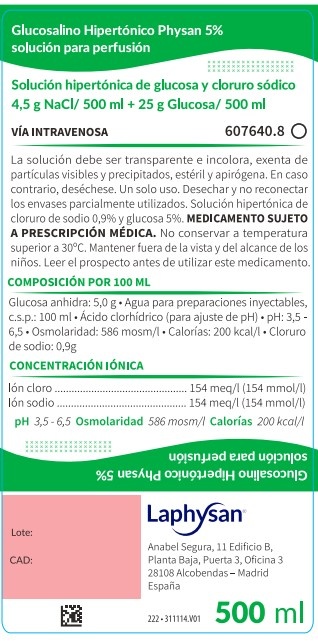

GLUCOSALINO HIPERTÓNICO PHYSAN SOLUÇÃO PARA PERFUSÃO

Pergunte a um médico sobre a prescrição de GLUCOSALINO HIPERTÓNICO PHYSAN SOLUÇÃO PARA PERFUSÃO

Como usar GLUCOSALINO HIPERTÓNICO PHYSAN SOLUÇÃO PARA PERFUSÃO
Introdução
Prospecto: informação para o utilizador
Glucosalino Hipertónico Physan solução para perfusão
Cloreto de sódio, Glucosa anidra
Leia todo o prospecto atentamente antes de começar a usar o medicamento, porque contém informações importantes para si
- Conserva este prospecto, porque pode ter que voltar a lê-lo.
- Se tiver alguma dúvida, consulte o seu médico, farmacêutico ou enfermeiro.
- Se experimentar efeitos adversos, consulte o seu médico, farmacêutico ou enfermeiro, mesmo que se trate de efeitos adversos que não aparecem neste prospecto. Ver secção 4
Conteúdo do prospecto
- O que é Glucosalino Hipertónico Physan e para que é utilizado
- O que precisa saber antes de começar a usar Glucosalino Hipertónico Physan
- Como usar Glucosalino Hipertónico Physan
- Possíveis efeitos adversos
- Conservação de Glucosalino Hipertónico Physan
- Conteúdo do envase e informação adicional
1. O que é Glucosalino Hipertónico Physan e para que é utilizado
Glucosalino Hipertónico Physan pertence ao grupo de medicamentos denominado soluções que afetam o balanço electrolítico. Electrolitos associados com hidratos de carbono.
É utilizado como aporte de sais e água nos casos em que exista desidratação com perdas moderadas de sais e água: vómitos, diarreias, fístulas, sudorese excessiva, em casos de necessitar a administração de água, hidratos de carbono e sais e metabolismo alterado dos açúcares: vómitos acetonémicos, coma insulínico.
2. O que precisa saber antes de começar a usar Glucosalino Hipertónico Physan
Não use Glucosalino Hipertónico Physan:
Se é alérgico ao cloreto de sódio, glucosa anidra ou a algum dos outros componentes deste medicamento (incluídos na secção 6).
Se sofre de:
- Hiperhidratação extracelular ou hipervolemia
- Retenção de líquidos e sódio
- Doenças graves dos rins.
- Doenças do coração.
- Hipernatremia (excesso de sódio no sangue)
- Hipercloremia (excesso de cloro no sangue)
- Edema generalizado ou cirrose ascítica
- Não deve ser administrado nas 24 horas seguintes após sofrer um traumatismo craniano.
- Diabetes descompensada ou outras intolerâncias conhecidas à glucosa, coma hiperosmolar, hiperglicemia e hiperlactacidemia.
Advertências e precauções
Consulte o seu médico, farmacêutico ou enfermeiro antes de começar a usar Glucosalino Hipertónico Physan.
A solução é hipertónica com uma osmolaridade aproximada de 586 mosmol/l.
A perfusão de grandes volumes deve ser feita sob monitorização específica em pacientes com falhas do coração, pulmões ou rins.
Se sofre de descompensação cardiovascular ou recebe tratamento com corticosteroides ou corticotropina.
As sais de sódio devem ser administradas com precaução a pacientes com hipertensão, falha cardíaca, edema periférico ou pulmonar, disfunção renal, preeclampsia ou outras condições associadas com a retenção de sódio.
Devido a uma função renal imatura, prematuros e lactentes a termo podem reter um excesso de sódio. Por isso, em prematuros e lactentes a termo, as perfusões repetidas de cloreto de sódio apenas devem ser dadas após a determinação dos níveis de sódio séricos.
A perfusão de soluções de glucosa está contraindicada nas primeiras 24 horas após traumatismo craniano e a concentração de glucosa no sangue deve ser monitorizada cuidadosamente durante episódios de hipertensão intracraniana.
Em caso de ter sofrido ataques isquémicos agudos (diminuição ou ausência de circulação em artérias), pois a hiperglicemia se relacionou com um aumento no dano isquémico cerebral e dificuldade na recuperação.
Se sofre de diabetes ou doenças dos rins, o seu médico pode solicitar que se realizem análises de sangue para monitorizar o seu estado, pois é necessário controlar o balanço de água, glucosa e sais que existem no organismo.
Em diabetes, as soluções de glucosa podem ser utilizadas sempre que tenha sido instituído o tratamento adequado (insulina). A glicemia deve ser monitorizada regularmente em pacientes diabéticos e modificar os requisitos de insulina.
Se produzir hiperglicemia, a velocidade de perfusão deve ser ajustada ou administrar insulina.
Em tratamentos prolongados, deve ser proporcionado ao paciente um tratamento nutricional adequado.
Para evitar a hipopotasemia produzida durante a administração parenteral prolongada de glucosalina, pode ser adicionado potássio à solução glucosalina, como medida de segurança.
Não administrar sangue simultaneamente utilizando o mesmo equipamento de perfusão devido ao risco de pseudoaglutinação e/ou hemólise.
As soluções glicosadas para perfusão intravenosa são geralmente isotónicas. No entanto, no organismo as soluções glicosadas podem tornar-se extremamente hipotónicas fisiologicamente devido à rápida metabolização da glucosa
Dependendo da tonicidade da solução, do volume e da velocidade de perfusão e do estado clínico inicial do paciente e da sua capacidade para metabolizar a glucosa, a administração intravenosa de glucosa pode causar alterações electrolíticas, a mais importante das quais é a hiponatremia hiperosmótica.
Hiponatremia:
Os pacientes com liberação não osmótica de vasopressina (p. ex., em presença de estados críticos, dor, estresse pós-operatório, infecções, queimaduras e doenças do SNC), os pacientes com doenças do coração, do fígado e dos rins e os pacientes expostos a agonistas da vasopressina têm um risco especial de experimentar hiponatremia aguda após a perfusão de soluções hipotónicas.
A hiponatremia aguda pode causar uma encefalopatia hiponatrémica aguda (edema cerebral) caracterizada por cefaleia, náuseas, convulsões, letargia e vómitos. Os pacientes com edema cerebral têm um risco especial de sofrer um dano cerebral grave, irreversível e potencialmente mortal.
As crianças, as mulheres em idade fértil e os pacientes com distensibilidade cerebral reduzida (p. ex., em caso de meningite, hemorragia intracraniana e contusão cerebral) têm um risco especial de sofrer edema cerebral grave e potencialmente mortal causado por uma hiponatremia aguda.
Uso de Glucosalino Hipertónico Physan com outros medicamentos
Informar o seu médico ou farmacêutico se está utilizando, utilizou recentemente ou possa ter que utilizar qualquer outro medicamento.
O cloreto de sódio apresenta interação com as sais de lítio cuja excreção renal é diretamente proporcional aos níveis de sódio no organismo. Dessa forma, a administração de soluções que contenham cloreto de sódio pode acelerar a excreção renal do lítio, dando origem a uma diminuição da ação terapêutica deste.
As soluções contendo glucosa podem reduzir a eficácia terapêutica da insulina ou antidiabéticos orais (biguanidas, sulfonilureas).
A administração junto com corticoides pode dar origem a níveis altos de glucosa (ação hiperglicemiante) e retenção de água e sódio.
Se a administração de glucosa coincidir com um tratamento com glucósidos digitálicos (digoxina) pode produzir um aumento da atividade digitálica, existindo o risco de desenvolver intoxicações por estes medicamentos devido à hipopotasemia que pode provocar a administração desta solução se não for adicionado potássio.
As soluções com glucosa não devem ser administradas através do mesmo equipamento de perfusão que o sangue total, devido ao risco de que se produza hemólise e aglutinação.
Em qualquer caso, o médico deve verificar a compatibilidade dos medicamentos adicionados.
Medicamentos que potenciam o efeito da vasopressina
Os seguintes medicamentos aumentam o efeito da vasopressina, o que faz com que se reduza a excreção renal de água sem electrolitos e aumenta o risco de hiponatremia hospitalar após um tratamento indevidamente equilibrado com soluções para perfusão i.v.
- Medicamentos que estimulam a liberação de vasopressina; p. ex.: clorpropamida, clofibrato, carbamazepina, vincristina, inibidores seletivos da recaptação de serotonina, 3,4metilendioxi-N-metanfetamina, ifosfamida, antipsicóticos, narcóticos
- Medicamentos que potenciam a ação da vasopressina; p. ex.: clorpropamida, AINE, ciclofosfamida
- Análogos da vasopressina; p. ex.: desmopressina, oxitocina, vasopressina, terlipressina
Outros medicamentos que se sabe que aumentam o risco de hiponatremia são os diuréticos em geral e antiepilépticos como a oxcarbazepina.
Gravidez e lactação
Glucosalino Hipertónico Physan deve ser administrado com especial precaução em mulheres grávidas durante o parto, especialmente se for administrado em combinação com oxitocina, devido ao risco de hiponatremia.
Se está grávida ou em período de lactação, acredita que possa estar grávida ou tem intenção de engravidar, consulte o seu médico ou farmacêutico antes de utilizar um medicamento.
Se a administração for correta e controlada, não se esperam efeitos adversos durante a gravidez e a lactação.
Até o momento, não se dispõe de dados epidemiológicos relevantes, por isso se recomenda que, se for utilizado durante este período, seja feito com precaução.
Condução e uso de máquinas:
Não se aplica, devido às características do seu emprego.
3. Como usar Glucosalino Hipertónico Physan
O seu médico indicará a dose mais adequada para as suas necessidades. Geralmente, é recomendada a administração intravenosa gota a gota de acordo com a sua idade, peso corporal, situação clínica e estado metabólico.
A dosagem recomendada é:
-para adultos, idosos e adolescentes: 500 ml a 3 litros cada 24 horas.
-para lactentes e crianças:
de 0 a 10 kg de peso corporal: 100 ml/kg/24 h.
de 10 a 20 kg de peso corporal: 1000 ml + (50 ml/kg por acima de 10 kg)/24 h.
>20 kg de peso corporal: 1500 ml + (20 ml/kg por acima de 20 kg)/ 24 h.
A velocidade de perfusão é normalmente de 40 ml/kg/24 h em adultos, idosos e adolescentes.
Em pacientes pediátricos, a velocidade de perfusão é de 5 ml/kg/h em média, mas este valor varia com a idade: 6-8 ml/kg/h para crianças menores de 12 meses, 4-6 ml/kg/h para crianças de 12-23 meses e 2-4 ml/kg/h para crianças em idade escolar (2-11 anos).
A velocidade de perfusão não deve exceder a capacidade de oxidação de glucosa do paciente, com o objetivo de evitar hiperglicemia (excesso de açúcar no sangue). Por isso, a dose máxima oscila desde 5 mg/kg/min. para adultos a 10-18 mg/kg/min. para lactentes e crianças, dependendo da idade e da massa total corporal.
Se for administrado continuamente no mesmo local de perfusão, pode produzir-se tromboflebite (inflamação das veias).
Deve ser prestada especial atenção se for utilizado em pacientes de idade avançada, devido a que podem ter afetadas as funções hepáticas e/ou renais.
As sais de sódio devem ser administradas com precaução a pacientes com hipertensão, falha cardíaca, edema periférico ou pulmonar, disfunção do rim, convulsões ou outras condições associadas com a retenção de sódio.
É recomendável que se realizem controles do balanço de água, sais e glucosa, especialmente se houver descompensação cardiovascular ou se receber um tratamento com corticosteroides ou corticotropina.
Se a si lhe foi administrado mais Glucosalino Hipertónico Physan solução para perfusão do que devia:
- Em caso de sobredosagem, pode aparecer hiperglicemia (alta concentração de açúcar no sangue), glicosúria (açúcar na urina), hiperhidratação ou hipernatremia (alta concentração de sódio no sangue) e edema generalizado (acumulação de líquido). A administração deve ser suspensa e recorrer ao tratamento sintomático.
- A administração prolongada ou rápida de grandes volumes de soluções contendo glucosa pode dar origem a hiperosmolaridade (risco de perda de consciência ou confusão mental), desidratação, hiperglicemia, hiperglicosúria e diurese osmótica (devido à hiperglicemia).
- A hiperglicemia deve ser vigilada especialmente nos casos graves de diabetes mellitus, podendo ser evitada diminuindo a dose e a velocidade de perfusão ou bem administrando insulina.
- O abuso ou uma administração demasiado rápida podem dar origem a um excesso de água e sódio (hipernatremia) com risco de edema, especialmente quando há uma excreção renal defeituosa de sódio. Neste caso, pode ser necessária uma diálise renal extra.
- Raramente se produz hipernatremia após doses terapêuticas de cloreto de sódio. O efeito mais sério da hipernatremia é a desidratação do cérebro, o que causa sonolência e confusão que progride para convulsões, coma, insuficiência respiratória e morte. Outros sintomas incluem sede, salivação e lagrimejo reduzidos, febre, taquicardia, hipertensão, dor de cabeça, vertigem, cansaço, irritabilidade e debilidade.
- A administração excessiva de sais de cloro pode produzir uma perda de bicarbonato com efeito acidificante.
Em caso de sobredosagem ou ingestão acidental, consultar o Serviço de Informação Toxicológica. Telefone: 915 620 420.
4. Possíveis efeitos adversos
Como todos os medicamentos, este medicamento pode produzir efeitos adversos, embora nem todas as pessoas os sofram.
À administração desta solução, observou-se que se produz com frequência hiperhidratação (retenção de líquidos) e falha do coração em pacientes com doenças do coração ou edema pulmonar e alterações electrolíticas assintomáticas
Uma administração demasiado rápida pode provocar hiperglicemia e síndrome hiperosmolar (risco de perda de consciência ou confusão mental) especialmente em intolerantes à glucosa.
Podem produzir-se reações adversas associadas à técnica de administração, incluindo febre, infecção no local da injeção, reação ou dor local, irritação venosa, trombose venosa ou flebite estendendo-se desde o local da injeção, extravasação e hipervolemia.
As reações adversas podem estar associadas aos medicamentos adicionados à solução, a natureza do medicamento adicionado determinará a possibilidade de qualquer outro efeito indesejável.
Reações adversas
Trastornos do metabolismo e da nutrição com hiponatremia hospitalar** de frequência não conhecida.
Trastornos do sistema nervioso com encefalopatia hiponatrémica** de frequência não conhecida.
** A hiponatremia hospitalar pode causar um dano cerebral irreversível e a morte devido à aparência de uma encefalopatia hiponatrémica aguda
Comunicação de efeitos adversos
Se experimentar qualquer tipo de efeito adverso, consulte o seu médico, farmacêutico ou enfermeiro, mesmo que se trate de possíveis efeitos adversos que não aparecem neste prospecto. Também pode comunicá-los diretamente através do Sistema Espanhol de Farmacovigilância de Medicamentos de Uso Humano: www.notificaRAM.es. Mediante a comunicação de efeitos adversos, você pode contribuir para proporcionar mais informações sobre a segurança deste medicamento.
5. Conservação de Glucosalino Hipertónico Physan
Mantenha este medicamento fora da vista e do alcance das crianças.
Frascos de vidro: Não se requerem condições especiais de conservação.
Frascos de polipropileno: Conservar por debaixo de 30°C.
Não utilize este medicamento após a data de caducidade que aparece na etiqueta após CAD. A data de caducidade é o último dia do mês que se indica.
Não utilize este medicamento se observar indícios visíveis de deterioração.
Os medicamentos não devem ser jogados nos deságues nem na lixeira. Pergunte ao seu farmacêutico como se livrar dos envases e dos medicamentos que já não precisa. Dessa forma, ajudará a proteger o meio ambiente.
6. Conteúdo do envase e informação adicional
Composição de Glucosalino Hipertónico Laphysan
- Os princípios ativos são: por 100 ml, cloreto de sódio 0,9g, glicose anidra 5g.
- Os demais componentes (excipientes) são: água para preparações injetáveis e ácido clorídrico (para ajuste de pH).
A composição electrolítica é:
Íon sódio 154 mmol/l, (154 meq/l).
Íon cloro 154 mmol/l, (154 meq/l).
Osmolaridade teórica: 586 mosm/l.
Calorias teóricas: 200 kcal/l.
pH: 3,5-6,5.
Aspecto do produto e conteúdo do envase
Solução transparente e incolor, sem partículas visíveis, estéril e apirógena.
Glucosalino Hipertónico Physan é uma solução para perfusão que se apresenta em envases de 100 ml contendo 50 ml ou 100 ml de solução, envases de 250 ml, 500 ml e 1000 ml.
Apresenta-se em frascos de vidro tipo II, Frascos de polipropileno (Tampa Flip Off), Frascos de Polipropileno (Tampa twin head), das seguintes capacidades:
- Frascos de 100 ml contendo 50 ml ou 100 ml de solução.
- Frascos de 250 ml
- Frascos de 500 ml
- Frascos de 1000 ml.
Dispõe-se também de envases clínicos com as seguintes apresentações:
- 30 frascos de 100 ml contendo 50 ml ou 100 ml de solução.
- 24 frascos de 250 ml
- 10 frascos de 500 ml
- 20 frascos de 500 ml
- 10 frascos de 1000 ml.
Titular da autorização de comercialização e responsável pela fabricação
Titular da autorização de comercialização:
LAPHYSAN, S.A.U.
Anabel Segura, 11 Edificio A, Planta 4, Puerta D
28108 Alcobendas – Madrid, Espanha
Responsável pela fabricação:
S.M. FARMACEUTICI SRL
Zona industrial
85050 TITO – POTENZA, Itália
ou
Laboratórios Basi - Indústria Farmacêutica S.A.
Parque Industrial Manuel Lourenço Ferreira, Lotes 8, 15 e 16
3450-232 Mortágua
Portugal
Data da última revisão deste prospecto:Outubro 2022
------------------------------------------------------------------------------------------------------
Esta informação está destinada unicamente a profissionais do sector sanitário:
Este medicamento será administrado sempre por pessoal especializado. Será administrado por perfusão, por uma veia central ou periférica.
A solução deve ser transparente, sem partículas e não conter precipitados. Não administrar em caso contrário.
O conteúdo de cada frasco é para uma única perfusão, deve-se descartar a fração não utilizada.
Utilizar um método asséptico, para administrar a solução e em caso de preparação de misturas.
Antes de adicionar medicamentos à solução ou de administrar simultaneamente com outros medicamentos, deve-se comprovar que não existem incompatibilidades.
Descartar após um único uso.
Descartar os envases parcialmente usados.
Não reconectar envases parcialmente utilizados.
Pode ser necessário vigiar o balanço hídrico, a glicose sérica, o sódio sérico e outros eletrólitos
antes e durante a administração, especialmente em pacientes com aumento da liberação não osmótica de vasopressina (síndrome de secreção inadequada da hormona antidiurética, SIADH) e em pacientes que recebam medicação concomitante com agonistas da vasopressina devido ao risco de hiponatremia.
A vigilância do sódio sérico é especialmente importante quando se administram soluções fisiologicamente hipotônicas. Glucosalino hipertônico Physan pode tornar-se extremamente hipotônico após a sua administração devido à metabolização da glicose no corpo.
- País de registo
- Substância ativa
- Requer receita médicaSim
- Fabricante
- Esta informação é apenas para referência e não constitui aconselhamento médico. Consulte sempre um médico antes de tomar qualquer medicamento. A Oladoctor não se responsabiliza por decisões médicas baseadas neste conteúdo.
- Alternativas a GLUCOSALINO HIPERTÓNICO PHYSAN SOLUÇÃO PARA PERFUSÃOForma farmacêutica: PERFURAÇÃO INJETÁVEL, 0,09 g / 0,07 g / 1,6 g / 0,17 g / 12,5 g / 0,19 g / 1,23 gSubstância ativa: electrolytes with carbohydratesFabricante: Fresenius Kabi España, S.A.U.Requer receita médicaForma farmacêutica: PERFURAÇÃO INJETÁVEL, 0,31 g / 21,9 mg / 0,03 g / 0,6 gSubstância ativa: electrolytes with carbohydratesFabricante: Fresenius Kabi España, S.A.U.Requer receita médicaForma farmacêutica: PERFURAÇÃO INJETÁVEL, NASubstância ativa: electrolytes with carbohydratesFabricante: Fresenius Kabi España, S.A.U.Requer receita médica
Alternativas a GLUCOSALINO HIPERTÓNICO PHYSAN SOLUÇÃO PARA PERFUSÃO noutros países
As melhores alternativas com o mesmo princípio ativo e efeito terapêutico.
Alternativa a GLUCOSALINO HIPERTÓNICO PHYSAN SOLUÇÃO PARA PERFUSÃO em Польша
Alternativa a GLUCOSALINO HIPERTÓNICO PHYSAN SOLUÇÃO PARA PERFUSÃO em Украина
Médicos online para GLUCOSALINO HIPERTÓNICO PHYSAN SOLUÇÃO PARA PERFUSÃO
Avaliação de posologia, efeitos secundários, interações, contraindicações e renovação da receita de GLUCOSALINO HIPERTÓNICO PHYSAN SOLUÇÃO PARA PERFUSÃO – sujeita a avaliação médica e regras locais.














